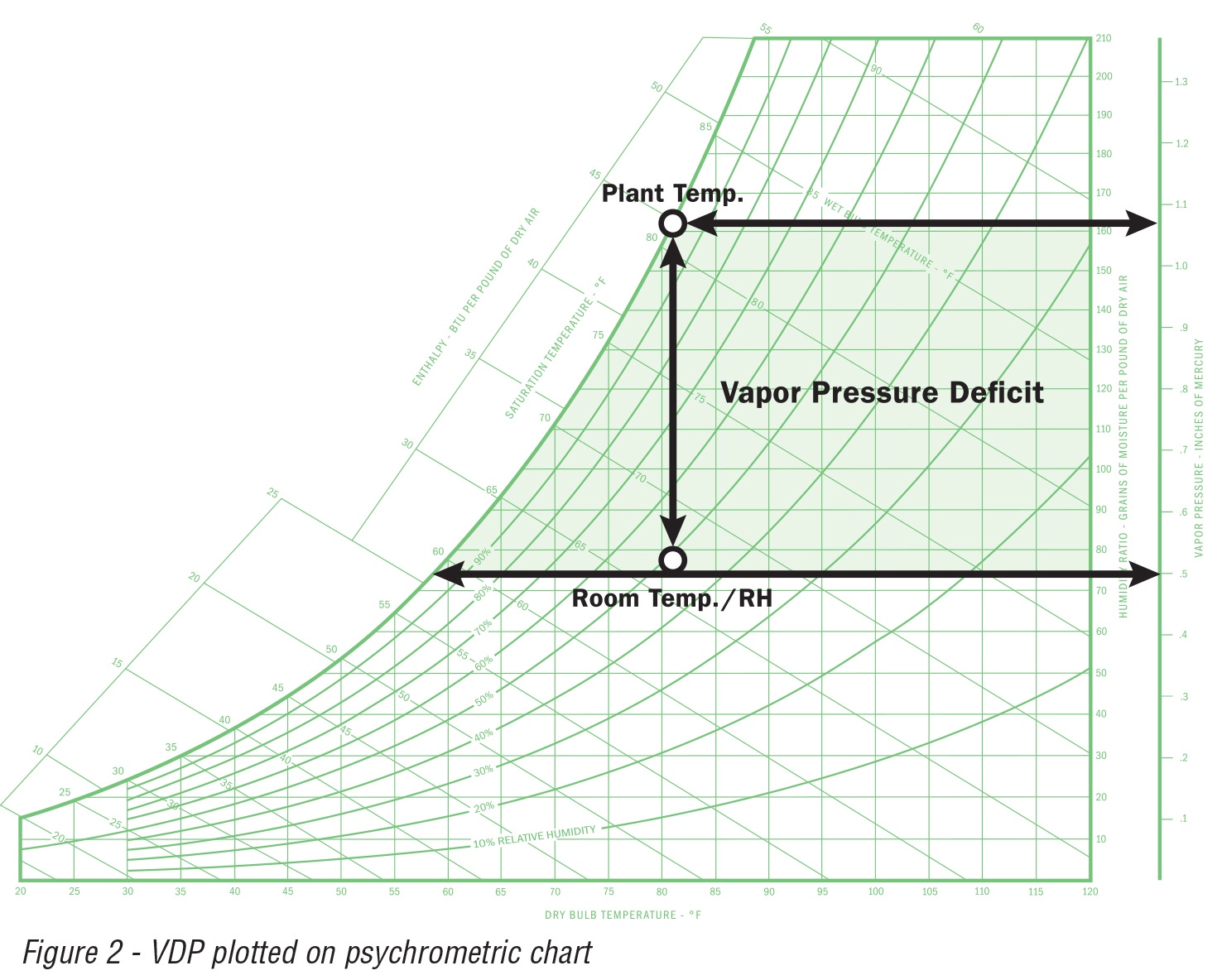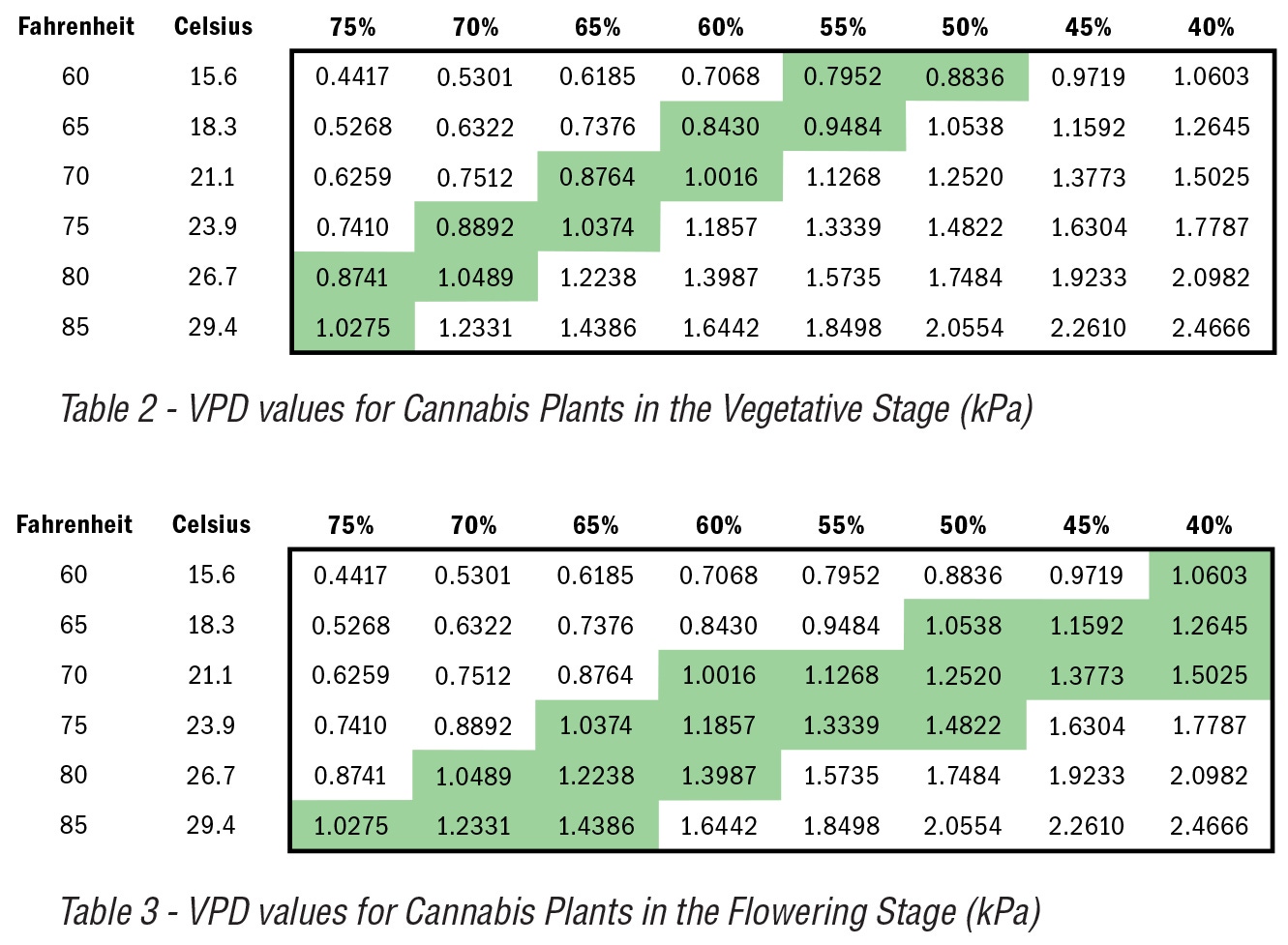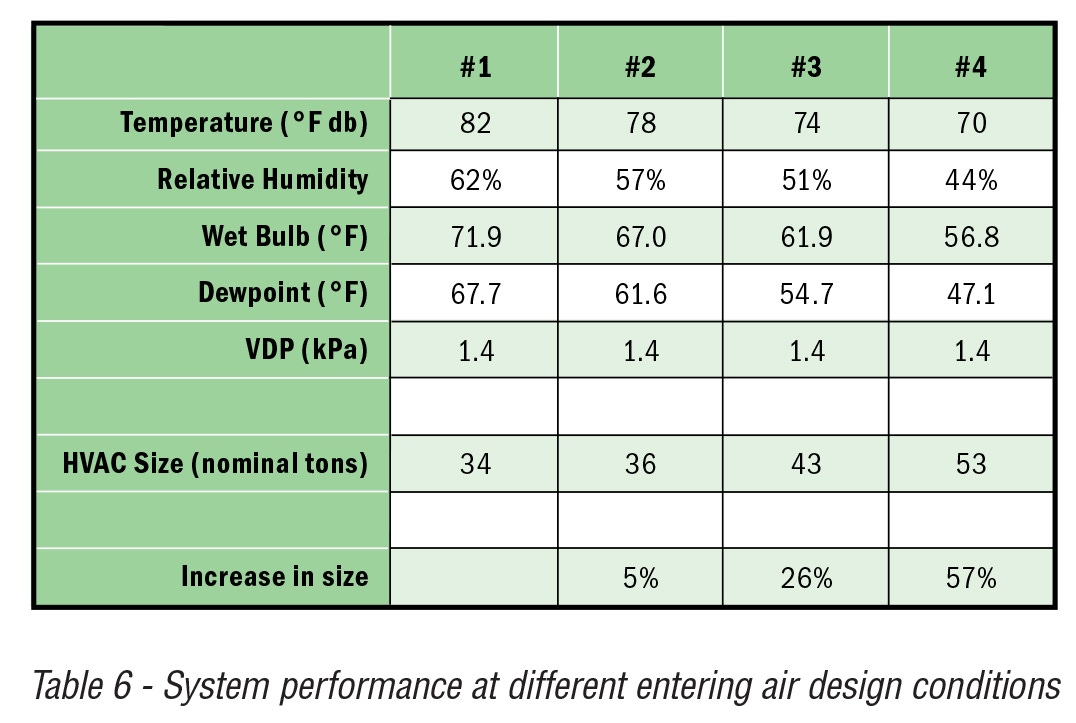Vapor Pressure Deficit and HVAC System Design
Overview
This application note defines Vapor Pressure Deficit (VPD) and discusses the impact VPD has on plant yields, protecting crops, the sizing of environmental control equipment and associated costs.
Introduction
There exists a communication gap between different players in the grow room industry that at times complicates the ability for all parties to get on the same page. One of the largest gaps exists when growers and their botany consultants talk to HVAC engineers about the environmental control side of the cultivation business.
Each group has its own glossary of terms and, more importantly, has a different frame of reference on what is the most critical design element. One of the design elements most often at the center of misunderstandings and debates is Vapor Pressure Deficit (or Differential), commonly referred to as VPD.
This application note views the discussion from both perspectives by properly defining what is Vapor Pressure Deficit. We will also discuss the impact VPD has on plant yields, protecting crops, the sizing of environmental control equipment and associated costs.
Plant Growth Process
Plants obtain their water and nutrients from their root systems through a process known as osmosis. The plants use these elements, along with the photosynthesis process, to help convert light energy to create glucose. The glucose is used during cellular metabolism in plant tissues to create energy for immediate use or to create complex sugars – starches – for later use.
As byproducts of plant processes that include photosynthesis, plants release from their stomata oxygen and water vapor. This cycle requires the absorption of energy (see Figure 1) and is known as transpiration. Evaporation is the water that is converted from grow room soil or crop trays from a liquid state to vapor in the air. The total moisture release is known as Evapotranspiration. Refer to Desert Aire Application Note 25 ‐Grow Room Load Determination for a more detailed discussion of this topic.
| Heat of Vaporization Summary |
|
The amount of energy required to convert liquid water into vapor is approximately 1,060 Btuh per pound of liquid water. In grow room terms 2,600 watts of heat are needed to vaporize each gallon of water. The process requires approximately 50% of grow room light heat output to complete the conversion. This means that 5,200 watts of lighting would vaporize one gallon/hour. Growers can estimate the maximum watering rate their plants can accommodate through use of the formulas below. The formulas calculate the volume of water that can be vaporized each day through the evapotranspiration process in grow rooms. Gallons Per Day (GPD) watering rate estimate: For 12 hour lights-on GPD = Watts lighting / 325 For 18 hour lights-on GPD = Watts lighting / 260 |
| Figure 1- Heat of Vaporization Summary |
Table 1 provides a summary of watering rates and corresponding dehumidification moisture removal capacities at various lighting loads.
 |
Colder temperatures tend to slow down plant growth because the rate of photosynthesis is reduced. Temperatures that approach 65°F (18°C) or lower are likely to retard plant growth. In addition, at these lower temperatures the water in the root system begins to lose its ability to hold dissolved oxygen. This allows pathogens to multiply, as those pathogens that weaken plants grow better with less oxygen. Thus, plants are more susceptible to certain types of mold when grow rooms are cool, especially if grow rooms are also damp. Indoor plants are much more susceptible to cold than plants grown outdoors.
When temperatures rise above 80°F, the rate of cannabis growth slows. The cannabis plants must use part of their energy to dissipate heat and to keep their water content constant. The rate of growth continues to slow as the temperature rises. Photosynthesis and plant growth cease altogether somewhere above 90°F.
Mold & Mildew
Air with a high Relative Humidity (RH), greater than 80% RH, can create an environment conducive to the creation of mold and mildew. During this high RH condition plant stomata close, eliminating the transpiration of moisture from plant leaves. Instead, water can permeate the leaves or remain on them in the form of droplets and puddles. This provides the setting for quick mold and mildew formation.
Vapor Pressure Deficit
Vapor pressure deficit is a metric that indicates the evapotranspiration potential of grow rooms based on current temperatures and humidity levels. The value is the deficit or differential between the pressure exerted by the moisture at a specific room condition, and the pressure at saturation. The assumption is made that the surface conditions of plant leaves are equal to that of the saturated conditions surrounding them.
When a space is at 100% relative humidity no further water can be absorbed by the air, consequently no further evapotranspiration can occur from plants. When the temperature increases, plants will need to transpire more. Growers and their HVAC systems must control VPD levels to ensure plants can transpire.
On the other end of the spectrum, when the relative humidity gets too low, then stomata will also close to try and preserve the moisture in plants. This weakens the plants and makes them more susceptible to disease, just as humans in stressed states become susceptible to illness.
We should note that VPD and RH are inversely proportional to one another when the air temperature is static. A high VPD is associated with a low RH while the inverse is true that a low VPD occurs at a high RH.
VPD is a direct method of evaluating the potential water stress on plants by providing growers with a predictive value of expected evapotranspiration. Growers are more familiar with RH, but the key element of this metric is the term “relative,” as this value does not reflect the absolute moisture in the air unless the simultaneous temperature is known. Refer to Desert Aire Technical Bulletin #3 – Dehumidification and the Psychrometric Chart for a detailed discussion. RH is a measure of what percentage of moisture is in the air at that specific temperature.
The vapor pressure and dewpoint are direct measures of the amount of moisture in air. The indoor grow industry has used vapor pressure because it provides the best link to plant health. Vapor pressure accounts for both temperature and humidity levels. This is important because growers may want to change the temperatures for day vs. night, different stages of growth, and different product strains or types.
Psychrometric Definition
Vapor pressure deficit can be demonstrated on a psychrometric chart. The example below demonstrates the change in the vapor pressure at a fixed temperature. The calculations can also easily be completed at other conditions.
 |
 |
Table 2 and Table 3 display VPD values at a range of temperaturesand relative humidities for cannabis plants in the vegetative and flowering stages respectively. The green bands are typical target operating ranges. As will be explained later, the choices of temperature and relative humidity will have a significant impact on the sizing and total ownership costs of HVAC equipment. Once growers establish target VPDs, they should select conditions to minimize the capital and operational costs of environmental control equipment.
The control and management of indoor grow environments requires an understanding of crop types as well as desirable crop temperatures, relative humidities and vapor pressures. The photosynthesis requirements of plants must also be understood.
Vapor pressure deficits indicate the evapotranspiration potential of grow rooms and their plant canopies. Ideal VPDs change with the different stages of plant growth and vary with the types of lighting used in grow rooms. Vapor pressure deficits can be determined by looking up corresponding values on a psychrometric chart or through calculations using known formulas. Today these formulas are readily available in apps or spreadsheets. The most common unit of measure for growers is kilopascals (kPa). Design engineers typically use either kPa or inches of Mercury (in Hg).
| Vapor Pressure Conversion Factors |
|
The following conversion factors can be used to translate between vapor pressure values used by growers and engineers. kPa = 3.386 x in Hg in Hg = 0.296 x kPa HectoPascals = 10 x kPa or 33.86 x in Hg |
| Figure 3 - Vapor Pressure Conversion Factors |
Most plants will have a unique VPD requirement for individual stages of growth. These VPD values may be different for lights on vs. lights off modes. Botanists generally list the
growth stages of plants as the following:
• Germination / Cloning
• Vegetative
• Flowering or early fruit generation
• Mature fruit formation
At 100% RH, the VPD is zero. A target VPD rate for optimized transpiration generally falls within a range of 0.5 to 1.5 kPa depending on the growth stage of the plant. By altering the VPD, growers can regulate the uptake of water and nutrients by plants. Thus VPD becomes a metric that growers and the engineers designing their climate control systems can use as the basis of understanding the grow room conditions they seek to create.
 |
VPD Impact on Growth
When VPD is held constant, growth and yield will improve with increasing temperature. In contrast, growth declines when the VPD is increased and temperature is held constant. The slower or reduced growth is in response to plants reaching a maximum transpiration rate.
When VPDs are relatively high, between 0.5 and 1.2 kPa, plants increase growth‐inducing transpiration by opening stomata and releasing a considerable amount of water vapor into the air. This increase in transpiration results in an increase in plant photosynthetic activity, requiring more nutrients to improve overall growth. However, at high VPD (> 1.5 kPa) the plant would close its stomata to avoid releasing water vapor to the air, preventing dehydration due to excessive transpiration.
In flowering rooms where the VPD is too low (< 0.80 kPa), plants close their stomata to prevent releasing more water into the air. This reduces transpiration and the rate of photosynthesis. These reductions would significantly reduce crop yields.
VPD is essential when it comes to providing the best conditions for the development of plants, to understanding the watering requirements according to the nutrients used, and adjusting them correctly to meet grower expectations. The best way to keep a suitable VPD value is to use an integrated environmental control system to maintain a tight temperature and dewpoint condition in the space.
Understanding the fundamental impact that temperature and VPD have on growth and yield, it is important for growers to define these variables first as they plan their facilities. Once those have been determined, growers can decide on relative humidity targets for their grow spaces.
Table 5 presents values for relative humidities at certain temperatures and VPDs that are required to maintain ideal growing conditions.
 |
HVAC Performance
The impact of temperature and relative humidity on equipment performance is a significant element in the cost of purchasing and installing HVAC equipment. These operational variables will also influence the amount of energy required to operate the HVAC equipment.
Table 6 displays the size of the environmental control system needed to remove the moisture in an indoor flowering room that has 2,000 square feet of cannabis canopy, watered at a rate of 270 gallons per day. Note that all of these design conditions have the same vapor pressure deficit. This analysis is for a maximum watering rate in a flowering room at full plant growth.
 |
A key design consideration is the selection of the design temperature. As Table 6 demonstrates, while a constant growth potential is being maintained for the plants, the design temperature and relative humidity selected will dictate the actual size and total ownership costs of the environmental control system needed. If the grower selects design condition #4, initial capital expenditures or first costs for the increased system size will be more than double the baseline system #1. Then the grower will incur higher annual operational costs to maintain this environment at the lower design conditions.
Air Distribution
Air distribution is an important component in optimizing the capital costs of grow room climate control systems, and ensuring the health of crops. If good air distribution systems are utilized, growers can obtain very uniform climatic conditions in grow rooms and eliminate the possibility of damaging microclimates under plant canopies. With homogenous environments the growers can operate at higher air temperatures and still ensure appropriate vapor pressure deficits across and throughout plant canopies. This eliminates the possibility of mold and mildew forming while improving the growth rate and quality of plants.
| Air Change Calculation | |
|
A method to measure the effectiveness of your air distribution system is to calculate the air changes in the space. To calculate HVAC system air changes, use the following formula: |
|
| Air Change = |
Total cubic feet of room [Cubic feet per minute (CFM) of the systems / 60 minutes per hour] |
| Figure 4 - Calculating Air Changes |
The targeted air change for environmental control systems should be a minimum of eight air changes per hour. Most growers install supplemental fans to provide additional recirculation capacity by aiming the fans at plant canopies. The value of these fans is they move air at target conditions while the HVAC supply air might need to be at temperatures as cold as 55° F.
For example, if the grow space is maintained at 78°F db and 57% RH the grow space dewpoint is 61.5°F. If any of the HVAC supply air is below this value and directly hits the plants this will create condensation on the plants. The potential for mold and fungi to grow is significant.
This is one of the main reasons why discharge supply air from HVAC systems should be directed toward the walls and open aisle areas so it does not strike the plants. Additional recirculation fans will assist in blending the HVAC supply air with the room air to quickly create a mixture that is above the room dewpoint.
An example of a desirable supply air and return air configuration is shown in Figure 5. Note supply air is directed along grow room walls. Return air vents are at high and medium vertical positions in the wall opposite the supply air entry point.
 |
Conclusions
Growers and HVAC design engineers must agree on what the most challenging environmental design conditions will be for each grow room depending on its cultivation and production purpose. Typically these peak load design conditions will be for lights‐on modes with the plants at the maximum watering rate for that growth stage. Partial load conditions will be met if the systems have the capacity for peak loads and proper environmental controls are part of the overall system designs. Refer to Desert Aire Application Note 26 ‐ Grow Room Environmental Control, for more information on controlling grow room climates.
Due to capital cost implications, growers need to carefully define the desired air temperatures and vapor pressure deficits they will use to produce maximum yields. Arbitrarily choosing low temperatures to avoid condensation problems does not provide proper solutions.
Understanding the interplay of watering rates, plant growth cycles, room temperatures, humidity requirements and air distribution is essential. All must be carefully orchestrated to achieve successful grow room designs. Detailed communication between growers and HVAC design engineers must take place before the engineers begin designing grow room environmental control systems.
Related Products

GrowAire™ Systems
GrowAire™ Dehumidification Systems offer you complete indoor climate control and energy-efficient equipment designs to optimize the growth rates and desired qualities of crops.
